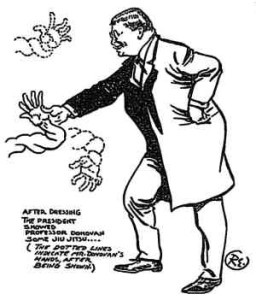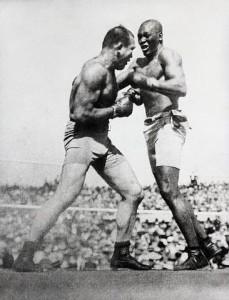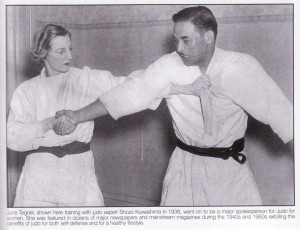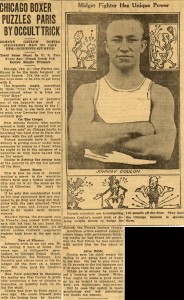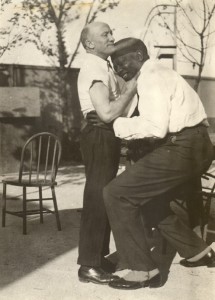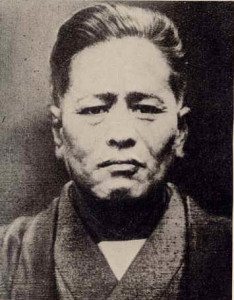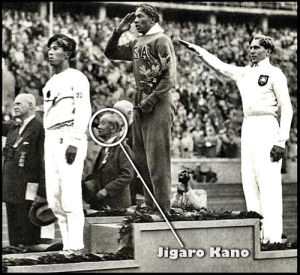I have been working on a timeline of Martial Arts in America and came across this one in Emil Farkas’s wonderful book. I have added some events that are directly related to John Keehan and Chicago to the timeline. I will continue to add things as I discover them. If any of you see any error or omissions please feel free to email me at fwebb@itutu.com
If you are going to research history you may as well attempt to make a serious effort. This timeline is in no way complete. The focus of my timeline is to find John Keehan’s influences and teachers and their connection to the overall world of martial arts. So far, in Chicago I have narrowed it down to Johnny Coulon for boxing, Mas Tamura for Judo, and Charles Guzanki was apparently his first karate instructor.
There will be some guff from “those who know but will not tell,” but it comes with the territory.
One of my interesting discoveries was footage of Bruce Tegner’s mom, June.
Chicagoans, June and John Tegner took their martial arts training to Hollywood and made a name for themselves as teachers and stunt people in films.
Bruce Tegner, whatever you think of his martial arts was a starting point for many young people who were interested in Judo and Karate in the 50s and 60s. John Keehan talked about reading his books when he was first interested in martial arts
Timeline of Martial Arts in America as it relates to John Keehan/Count Dante
Taken from An Illustrated History of Martial Arts In America by Emil Farkas
1902
• Yoshiaki Yamashita, 6th dan, was the first person to teach judo in the U.S. He arrived in 1902 at the invitation of Mr. Graham Hill, director of the Great Northern Railroad.
1903
• Yoshiaki Yamashita teaches Judo to society women and eventually to President Theodore Roosevelt, who become a 3rd Degree black belt. During his time in office there is a Judo dojo in the White House.
1904
• U.S. President Theodore Roosevelt starts studying judo with Yoshiaki Yamashita.• Russo Japanese war. Russian navy defeated at battle of Tsushima by Japanese navy commanded by Togo. Russian army defeated at battle of Mukden and seige of Port Arthur. Peace is brokered by Theodore Roosevelt and agreed by the Treaty of Portsmouth.
1907
• The first Kodokan judo school in the U.S. opens in Seattle.
1908
1909
• Kali is introduced to the U.S. by Jack Santos.
• First judo dojo, the Shunyokan, opens in Hawaii.
1910
• John Frederic Coulon(Johnny Coulon) – bantamweight boxing champion of the world from 6 March 1910 -1914. Coulon would become John Keehan’s boxing teacher in the early 1950s. Coulon becomes one of Jack Johnson’s best friends and is a pallbearer at his funeral.
1912
• Judo in the Tacoma, Washington, area started by Prof. Iwakiri, who was born in Japan, and who arrived here in 1912
• Judo champion and teacher Masato Tamura born in Fife Washington. Tamura will eventually have John Keehan as a Judo Student in mid 1950s Chicago.
1913
• Jigoro Kano visits Hawaii for the first time.
1916
• Heita Okabe, 4th dan; Toshitaka Yamauchi, 4th dan; and Ken Kawabara, 4th dan were teaching judo while studying at the University of Chicago; this would be the earliest organized judo activity in the midwest.
• Okinawan Master Gichin Funakoshi was the first expert to introduce karate-do to mainland Japan, in 1916.
1919
• The Chicago Judo Club was founded by Shozo Kuwashima. When Kuwashima moved to the West Coast, the Chicago Judo Club was taken over by John Osako and Ruth Gardner. June and Jon Tegner, the parents of Bruce Tegner were students of Kuwashima.
1920
• American Army officer Allan Corstorphin Smith publishes, The Secrets of Ju-jitsu: A Complete Course in Self Defense.
• Okinawan karate master Kentsu Yabu visits Hawaii and Los Angeles and demonstrates karate.
1921
• Boxer Johnny Coulon marries Marie Maloney (1892-1984) and together they open Coulon’s Gymnasium on the South Side of Chicago on East 63rd Street near the University of Chicago. Coulon is a best friend of World Boxing Champion Jack Johnsons and is a pall bearer at his funeral.
1929
• Henry Okazaki, Hawaiian martial arts instructor, publishes The Science of Self-Defense for Girls and Women.• Bruce Tegner born in Chicago, Illinois in 1929 to June Tegner, 3rd dan under Shozo Kuwashima of the Chicago Judo Club
1930
• Ark-Yuey Wong begins teaching kung-fu to Los Angeles-based Wong Wen-Sun Chinese Benevolent Association.
• Henry Okazaki establishes Danzan ryu ju-jutsu on Oahu, Hawaii.
1932
• Hawaiian Judo Yudanshakai (Black Belt Association) is founded.
• Shuji Mikami opens the first kendo school outside of Japan in Honolulu, Hawaii.
1933
• The first karate club to allow Caucasian membership is formed in the basement of Honolulu’s First Methodist Church. Its instructors are Mutsu Zuiho and Kamesuke Higaonna.
1934
• Goju-ry karate master Chojun Miyagi visits Honolulu where he demonstrates and teaches karate.
1936
• Taoro Mon begins teaching kendo in Los Angeles.
• Jesse Owens wins the 1936 Olympics in Berlin. Judo Master Jigaro Kano shares the dais with him when he recieves the gold medal.
1938
• Harry Auspitz incorporates the first judo club in the Chicago, the JiuJitsu Institute. The JuJitsu lnstitute became the first Kodokan Judo Club in Chicago,
1939
• John Timothy Keehan (Count Dante) born in Chicago February 4th.
1940
• The first intercollegiate judo competition takes place in Northern California between San Jose State and U.C. Berkeley.
1941
• During May of this year, Masato Tamura, 4th dan, came to Chicago from Fife, Washington,to teach at the Jiu Jitsu Institute.
• Dec 7 1941, Pearl Harbor Attacked by Japan
When World War II started in Dec. 1941, there were twenty-six dojo in southern California, with 422 black belts and about 2,000 students. The black belts were distributed in the following manner: 6th dan-2; 5th dan-5; 4th dan-6; 3rd dan-42; 2nd dan-101; 1st dan-264; and 2 honorary black belts. During World War II, judo continued to flourish in relocation camps such as Manzanar, Heart Mountain, Post Gila River, and Rule Lake. Although all other judo clubs ceased operations during the war years, Seinan Dojo kept its doors open. Jack Sirgel, then a 2nd dan, the head instructor, visited the Manzanar Relocation Camp with his students to improve their judo techniques, even when the war was at its peak. (The History of American Judo)
1942
• James Mitose starts to teach ju-jitsu in Honolulu.
• February 19, 1942, soon after the beginning of World War II, Franklin D. Roosevelt signed Executive Order 9066. The evacuation order commenced the round-up of 120,000 Americans of Japanese heritage to one of 10 internment camps—officially called “relocation centers”—in California, Idaho, Utah, Arizona, Wyoming, Colorado, and Arkansas.
1943
• August 1 Release of the Behind the Rising Sun, a wartime propoganda film starring Robert Ryan as a boxer who soundly defeats a Japanese judo master in pre-wartime Japan.
• In Chicago, 140 lb Mas Tamura chokes out 210 lb wrestler Karl Pojello in 1 minute and twenty second in a demonstration match for the US Military. This match was arranged by sportswriter for the Chicago Daily Times named Gene Kessler after the release of Behind the Rising Sun, “to find out about the comparative merits of our wrestling when matched against the Japs’ jujitsu.” First offically record mixed martial arts match??
1944
• William K.S. Chow begins teaching martial arts classes at the Nuuahu YMCA in Honolulu.
1945
• The final battles of the European Theatre of World War II as well as the German surrender took place in late April and early May 1945.
• August 6, the U.S. dropped the atomic bomb on the city of Hiroshima, Japan. 80,000 or so died within hours.
• August 9, the United States dropped another bomb – on Nagasaki. Finally Emperor Hirohito initiated an end to war.
• September 2, aboard the battleship Missouri, in Tokyo Bay, representatives of Japan met with the Allies to sign the surrender.
Immediately following Japan’s loss during World War II, all martial arts were banned for five years by the American occupation. This martial arts ban was due to the belief that martial arts before the war helped support and foster the nationalistic spirit that directly supported the growth of Japanese militarism.
No one was allowed to practice or teach any martial art. During the American occupation, however, Japanese martial artists were working towards the day when they could practice and teach again. In order to implore occupation authorities to lift the ban, efforts were made to stress the positive aspects of martial arts, and to treat them as sports rather than martial skills.
1946
• Robert Trias establishes the first karate dojo in the continental United States, in Phoenix, Arizona.
• Hank Okamura is relocated close to the Lawson YMCA in Chicago and joins the “Y.” Okamura, when wrestling at the YMCA, meets Kenji Okimoto; and the two men, who discovered they were both judoka, began to practice together. From this start, judo remained at Lawson YMCA for the next twenty years.
1947
• Kajukenbo, the first eclectic martial art in the U.S., is created by five Hawaiian martial artists: Walter Choo, Joseph Holke, Frank Ordonez, Adriano Emperado and Clarence Chang.
• The Chicago Judo Black Belt Association is formed and a charter is received directly from the Kodokan. (As a recognized judo organization the yudanshakai could promote up to 3rd-degree black belt.)
1948
• Henry Stone of California introduces weight divisions to U.S. judo competition.
• The United States Karate Association is founded by Robert Trias. It is the first karate organization in the U.S.
1949
• The Amateur Athletic Union recognizes judo as an official sport.
1952
• Karate Master Mas Oyama tours the U.S. and introduces karate to the American masses for the first time.
1953
• The U.S. Judo Black Belt Federation is formed.
• Koichi Tohei introduces aikido to Hawaii.
• The first Collegiate Judo Tournament is held in Berkeley, California.
• The first national AAU Judo Championship is held in San Jose, California
• Mel Bruno, under the sponsorship of Strategic Air Command, organizes a tour by 10 leading Japanese martial arts experts, who demonstrate their skills at Air Force bases across the country. The arts include judo, karate and aikido.
1954
• Ed Parker begins teaching kenpo karate in Provo, Utah.
• The San Diego Judo Club introduces aikido to the continental United States.
• Ed Kaloudis introduces Koeikan karate on the U.S. East Coast.
• William Dometrich introduces chito-ryu karate to the U.S. in Covington, Kentucky.
• Bobby Lowe founds the first overseas branch of kyoku shinkai karate in Honolulu.
1955
• The first after-school judo program is started by George Wilson at Kent Washington’s Kentridge High School.
• The first karate tournament in the U.S. is held by Robert Trias in Phoenix, Arizona.
• Shotokan karate is introduced to the U.S. by Tsutomu Oshima, who begins teaching in Los Angeles.
• John Keehan studies Boxing with Johnny Coulon at the South Side Gym• Tsutomu Ohshima, one of Master Funakoshi’s last direct pupils (1948-1953), came to the United States and was the first person to teach shotokan karate to the US public.
1956
• The first commercial karate dojo is opened in Honolulu by Carlton Shimomi. The style is shorin-ryu.
• Jerome Mackey introduces franchise martial arts to the U.S. when he opens a chain of judo clubs in New York City.
• Thoon Rhee introduces taekwondo to the U.S. when he begins teaching in San Marcos, Texas.
• Ed Parker moves to Pasadena and opens his first West Coast dojo.
1957
• Matsubayashi shorin-ryu karate instructor Louis Kowloski of St. Louis opens the first karate school in the Midwest.
• Cecil Patterson a wado-ryu karate instructor becomes one of the first to teach karate in the South. He begins teaching in Tennessee.
• Gordon Doversola introduces Okinawa-te to the U.S. He begins teaching in Los Angeles.
1958
• George Mattson introduces uechi-ryu karate to the U.S. He begins teaching in Massachusetts and opens the first karate school in the New England States.
• Mas Tsuroka introduces chito-ryu karate to Canada. He begins teaching in Toronto.
• Tsutomu Oshima sponsors the first Nisei Week Karate Championships in Los Angeles. It is the first traditional karate tournament in the U.S.
1959
• Peter Urban introduces Japanese goju-ryu karate to the U.S. He begins teaching in Union City, New Jersey.
• Hiroshi Onto introduces Renbukai karate to the U.S. in New York City.
• Alan Lee introduces Shaolin kung-fu on the East Coast, in New York City.
• Bruce Lee comes to Seattle and begins teaching wing chun in a covered parking lot of a Blue Cross clinic.
• Hidetaka Nishiyama’s and Richard C. Brown’s book, Karate. The Art of Empty Hand Fighting, is published in the U.S. It becomes an all time classic.
1960
• Anthony Mirakian introduces Okinawan goju-ryu karate in the U.S. He begins teaching in Watertown, Massachusetts.
• Yoshiaki Ajari begins to teach wado-ryu karate in Hayward, California.
• Dr. Maung Gyi introduces bando in the U.S. and begins teaching in Washington, D.C.
• S. Henry Cho opens the first taekwondo school in New York City.
• Isshin-ryu karate instructor, Steve Armstrong, begins to teach in Tacoma, Washington.
1961
• Black Belt Magazine unveils its first issue. Its founders are Mito and Jim Uyehara.
• Rusty Glichman, a female judoka, defeats a male opponent in an AAU sanctioned judo competition and the AAU bans women from participating in judo competition. It took 10 years for the ban to be lifted.
• Gosen Yamaguchi (son of Gogen “The Cat” Yamaguchi) introduces goju kai karate in California, while attending college in San Francisco.
• Richard Kim introduces shorin-ryu karate to the U.S. when he begins to teach at the Chinese YMCA in San Francisco.
• Teruyuki Okazaki one of the JKA’s top instructors, opens a dojo in Philadelphia where he begins teaching shotokan karate.
• Hidetaka Nishiyama, one of Japan’s leading shotokan karate instructors moves to Los Angeles and founds the All American Karate Federation.
• John Pachivas begins teaching karate in Florida.
• Hidetaka Nishiyama promotes the first large traditional karate tournament in the U.S., The All America Karate Federation Championships, in Los Angeles.
• American television viewers see karate for the first time when Bruce Tegner demonstrates the art in an episode of the TV series, The Detectives.• John Keehan begins to teach in Chicago. He runs afoulof the martial arts community by openly welcoming students of all races, following the example of his boxing teacher, Johnny Coulon and his first Karate Instructor, Robert Gruzanski.
1962
• John Leong introduces hung gar and tai chi chuan to Seattle, and includes many non-Chinese among his students.
• Chang Man-Che’eng publishes the first English language text of tai chi, Tai Chi Ch ‘uan: A Simplified Method of Calisthenics for Health and Self-Defense.
• Mas Oyama’s Kyohushinkai Organization sponsors the first open tournament in the U.S., the Northwest American Karate Championships held in New York City.• Gary Alexander defeats John Keehan in Mas Oyama’s First North American Karate Championships held at Madison Square Garden. Officials state that Keehan was disqualified.
• Al Weiss and Johnny Kuhl from New York produce Combat Karate, the first American magazine dealing exclusively with karate.
• Allen Steen opens the first karate school in Dallas.
• The first national collegiate judo championship is conducted at the U.S. Air Force Academy in Colorado Springs.
• The National Collegiate Judo Association is founded.
• Gene LeBell defeats boxer Milo Savage in the first Boxer vs. Martial Artist contest – Salt Laske City, Utah. 1963
• Robert Trias and John Keehan produce the first national karate tournament in the U.S. It was held in Chicago.
• Chuck Norris opens his first dojo in Torrance, California, where he teaches Tang soo do.
• Uechi-ryu karate instructor George Mattson is the first American to author a book on traditional karate style, The Way of Karate.
• Burmese bando expert Maung Gyi introduces bando to the U.S. and founds the American Bando Association. 1964
• J. Pat Burleson wins the First National Karate Championship
• Angel Cabales of Stockton, California opens the first school that teaches the Filipino martial arts to non-Filipinos.
• Tsutomu Oshima begins teaching the first accredited college karate course in the U.S. at the California Institute of Technology in Pasadena, California.
• Sea Oh Choi introduces hapkido to the U.S. when he begins teaching in Los Angeles.
• Jhoon Rhee promotes the first National Karate Championships in Washington, D.C.
• Ed Parker promotes the first Long Beach International Karate Championships.
• Bruce Lee makes his first major public appearance when he demonstrates at the Long Beach International Karate Championships in California.
• Mike Stone wins International Karate Grand Championship 1965
• Shito-ryu karate is introduced to the U.S. by Fumio Demura, who begins teaching in Santa Ana, California.
• Pauline Short opens the first karate school for women located in Portland, Oregon.
• Television covers sport karate for the first time when they televise karate matches from Thoon Rhee’s second National Karate Championships.
1963
• Judo Gene LeBell accepts a public challenge to fight boxer Milo Savage in Salt Lake City. Competing as a “judo/karate” fighter, LeBell defeated Savage – choking him unconscious in the 4th round.
• In 1963, John Keehan organizes, Robert Trias, the “First World Karate Tournament” in Chicago at the University of Chicago Gymnasium. Al Gene Carulia is the champion of this event.
1965
• On July 22, John Keehan and a companion are apprehended by Chicago Police as they try to light the fuse on dynamite caps to blow out the windows of Gene Wyka’s Judo School.
1966
• Jim and Al Tracey begin to franchise karate schools all over the U.S., which was the first large-scale karate franchise operation in the U.S.
• Bruce Lee begins his role as Kato on the TV series The Green Hornet.
• The USA Goju organization is founded by karate sensei Peter Urban of New York.
Joe Lewis and Bob Wall open Sherman Oaks Karate Dojo, first upscale martial arts school 1967
• Ninjas are introduced to the American public whenbthe James Bond movie You Only Live Twice is released nationwide.
• In New York, Aaron Banks promotes the first karate team competition.
• Shorinji kempo is introduced to the U.S. by Hirokazu Yamamori.
• Bruce Lee names his system jeet kune do.
• Top ten ratings for karate competitors begin by Black Belt Magazine.
• John Keehan conducts the first bare knuckle fill contact event in the U.S. in Chicago.
• Chuck Norris and Bob Wall create the first martial arts billing company, Martial Arts Acceptance. 1968
• Al Weiss begins publishing Official Karate Magazine, out of offices in Manhattan.
• Mito Uyehara publisher of Black Belt Magazine begins Black Belt Hall of Fame.
• The first professional karate tournament in the U.S. is promoted by Jim Harrison in Kansas City, Kansas.
• The PKA founded by Chuck Norris, Bob Wall and Mike Stone.
1967
First Full Contact tournament held in Chicago at the Coliseum.
1969
• Mito Uyehara begins publishing Karate Illustrated Magazine.
• The American The Kwon Do Association is founded in Little Rock, Arkansas by Haeng Ung Lee.
• The U.S. Judo Association is formed. 1970
• Chuck Norris, Joe Lewis, Mike Stone, Bob Wall and Skipper Mullins win the first World Professional Karate team title.
• Joe Corley and Chris McLoughlin begin promoting the Battle of Atlanta Karate Championships.
1970
• Jim Konsevic killed in a “dojo war” when he accompanies Count Dante on a visit to the Black Dragon Fighting Hall of the Green Dragon Society. Represented by Bob Cooley, who will go on to be Chicago Outfit lawyer, the case is thrown out of court. No one is ever convicted of Jim Konsevics murder.
1972
• The first martial arts T.V. series in America, Kung Fu, begins to air on ABC.
• Billy Jack is the first American movie to feature the Korean art of hapkido, which is instrumental in beginfling the martial arts boom that followed.
• Jhoon Rhee develops Safe-T-Equipment which revolutionizes American karate tournaments.
• AAU recognizes karate as an official sport.
• The American Collegiate Taekwondo Association is formed.
1973
• Inside Kung-Fu Magazine is founded by Curtis Wong in Los Angeles.
• Enter the Dragon is released and makes Bruce Lee a superstar.
• Mike Anderson’s Top Ten Nationals in St. Louis begins semi-contact karate competition. Howard Jackson wins.
1974
• Wu Shu Troupe from China tours the U.S. for the first time.
• Amateur Athletic Union recognizes taekwondo as an official sport.
• General Choi Hong Hi moves to Toronto and the International Taeckwondo Federation is now headquartered there.
1975
• Second World Professional Karate Championship is held in Los Angeles. Promoted by Mike Anderson, the event begins an era of full contact karate.
• Harold Long founds the International Goshinryu Karate Association, headquartered in Knoxville, Tennessee.
• An estimated 50 million views watch Jeff Smith and Karriem Allah compete in I 1 round full contact karate event. The fight was a preliminary bout to the Muhammed Ali!Joe Frazier fight “Thrilla in Manila” with Bob Wall doing commentary.
• Hidetaka Nishiyama conducts the first international Amateur Karate Federation World Championships in Los Angeles.
• John Keehan/Count Dante dies of “bleeding ulcers” a week before he is to return to the Grand Jury to answer questions about the 1974 $4 million Purolator Vault Robbery.
1976
• June 25, 1976, boxer Muhammad Ali and professional wrestler Antonio Inoki worked a 15-round draw at the Budokan in Tokyo. The match aired live on closed-circuit TV and drew 32,000 spectators to Shea Stadium in New York. Gene LeBell was the refree. The Shea Stadium card also featured boxer Chuck Wepner versus wrestler Andre the Giant, a match that reportedly inspired scenes in Sylvester Stallone’s Rocky films.
1977
• Teruyuki Okazaki, based in Philadelphia, founds the International Shotokan Karate Federation.
• The North American Tae Kwon Do Union is founded.
1979
• Graciella Casillas becomes the world’s first female full contact world companion.
• ESPN signs a deal with the Professional Karate Association for the right to broadcast full contact karate tournaments.
1980
• Curtis Wong begins a new magazine, Kick Illustrated.
• Stephen Hayes introduces togakure-ryu ninjutsu to the U.S. and the ninja craze in America begins.
• Chung Ding Sheng, grandmasters of shuai chiao tours America.
1982
• The martial arts video revolution begins when Joe Jennings founds Panther Video.
1987
• Mike Swain becomes the first American judoka to win a gold medal at the World Judo Championships.
1988
• Dana Hee and Arlene Limas become the first Americans to win Olympic taekwondo gold medals.
1989
• Billy Blanks’ tae bo becomes the newest exercise fad in America.
1991
• Cardio kickboxing begins to become a popular form of aerobic exercise especially among women. 1993
• Ultimate Fighting Championships is founded.
An Illustrated History Of Martial Arts In America – 1900 to Present
• No holds barred fighting begins to gain popularity across the country.
• Due to the UFC, grappling begins to become widely practiced, especially Brazilian ju-jutsu.
• Dragon: The Bruce Lee Story is released in theatres.
• Walker Texas Ranger begins on CBS starring Chuck Norris.
1994
• NAPMA is founded by John Graden.
1995
• Martial arts related websites are beginning to have a presence on the Internet.
1996
• Martial Arts Professional Magazine is launched by NAPMA.
1998
• K-1 comes to the U.S.
1999
• World Black Belt is founded by 53 amazing martial arts legends including Gene LeBell, Pat Burleson, Jim Harrison, Cung Le and General Choi Hong Hi.
2001
• The Martial Arts Industry Association (MAIA) is formed.
• Little Ninjas Program begins; promoted by NAPMA it launches the boom in the pre-school karate program.
• World Black Belt founders Lou Casamassa, David Krapes, Soloman Kaihewalu, Deanna Bivins and Bob Wall create AID, Aviation in Defense, and contract with Amercan Airlines to teach cabin crew self defense.
• Chuck Platten becomes Canadian Director of World Black Belt.
2004
• “Curse of the Dragon”, a documentary about Bruce Lee, produced by Fred Weintraub.
• World Black Belt creates the ultimate anti-aging, antidisease beverage: KO Fitness Recovery Drink.
2006
• Mixed Martial Arts becomes the new craze, with television embracing it, and the public getting behind it.
2007
• History Channel’s Human Weapon exposes millions of viewers to the real martial arts from around the world.
Ok this is enough for the night. I will get back to this later in the week. I have a ton of other work to get started now.
